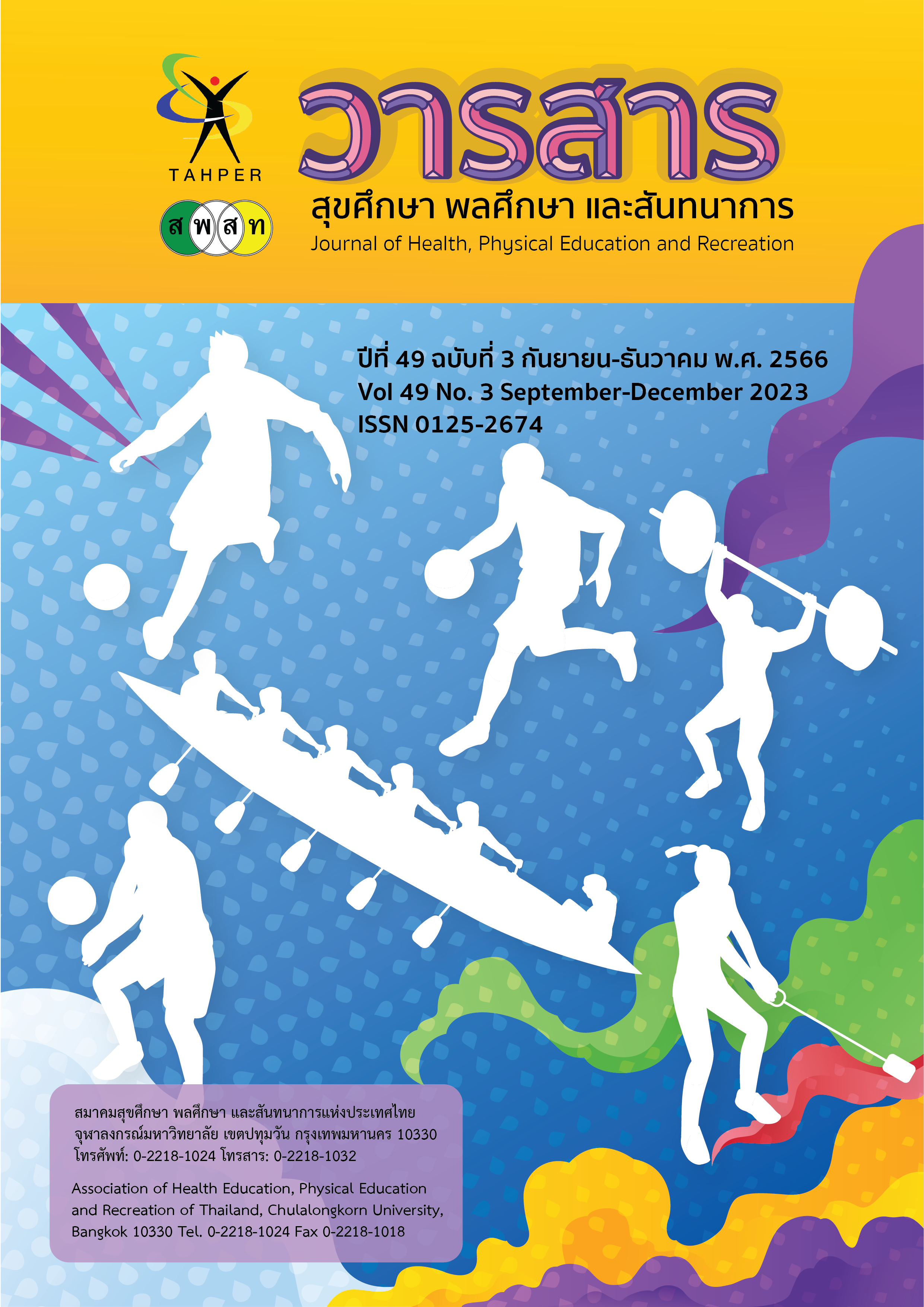Acute Effect of Short-Distance Running on Bone Metabolism
Main Article Content
Abstract
This research aims to study the Acute Effect of Short-Distance Running on the Treadmill on Bone Metabolism in Early-Adult female by using a comparison of the step touching on the treadmill between 2,500 steps and 5,000 steps. The research had purposive selection that consists of 20 early-adult females aged between 18-21 with BMI less than 23 kilograms/M2, without any osteopathy record or medical conditions, which affect the bone metabolism. This experimental research started by getting blood draws for the selective groups after 8 hour fasting to evaluate P1NP, OC, and CTX, and this selective group should not be on a period at that moment. The researcher divided the selective group into 2 groups of 10. The first group got the two-time blood draws within 30 minute difference without having any activities. The second group got the first blood draws before having short-distance running, and then ran with the speed at least 8 Km/hour, and once again got second blood draws immediately after the exercise finished. The researcher will compare the differences from the step count between 2,500 steps and 5,000 steps and this was repeatedly done after 1 week. The statistic formula used for this research is Average (X̅), Standard Deviation (S.D.), Two-way Multivariate Analysis of Variance with Repeated, and One-way Multivariate Analysis of Variance to find the variances following Tukey Statistic Test with specified the statistical significance at 0.05.
The research found that the short-distance running with 5,000 steps touching on a treadmill caused the decreasing of P1NP, OC, and CTX significantly while the 2,500 steps running caused the decreasing of only P1NP and CTX. The research also said that the 5,000 step-running got higher OC value than 2,500 step-running with statistical significance value 0.05. This came to the final conclusion that both activities could effect to the Bone Remodeling in Early-Age Female.
Article Details

This work is licensed under a Creative Commons Attribution-NonCommercial-NoDerivatives 4.0 International License.
Critical thinking in journals is the right of the author. The Association of Health Education, Physical Education and Recreation of Thailand is not always required, to create diversity in ideas and creativity.
ความคิด ข้อวิพากษ์ในวารสารเป้นสิทธิของผู้เขียน สมาคมสุขศึกษา พลศึกษา และสันทนาการแห่งประเทศไทยไม่จำเป็นต้องเห็นชอบด้วยเสมอไป เพื่อให้เกิดความหลากหลายในความคิดและความสร้างสรรค์
References
ธวัช ประสาทกุล. (2549). รอบรู้เรื่องกระดูกพรุน. เรือนปัญญา, กรุงเทพฯ.
Bailey CA, & Brooke-Wavell K. 2010. Optimal frequency of exercise for bone health: Randomised controlled trial of a high-impact unilateral intervention. Bone, 46. 1043-1049.
Bassey EJ, Rothwell MC, Littlewood JJ, &Pye DW. 1998. Pre- and postmenopausal women have different bone mineral density responses to the same high impact exercise. Journal of Bone and Mineral Research, 13. 1805-1813.
Cremers S, P Garmero and MJ Seibel. (2008). Biochemical markers of bone metabolism. In John P. Bilezikian, Lawrence G. Raisz, T. John Martin eds, Principles of Bone Biology. (3rd ed). Academic Press Inc, 1900
Drake A, AmstrongIII DW, Shakir KMM. (2004). Bone mineral density and total body bone mineral content in 18 to 22 year old women. Bone, 34. 1037-1043.
Greene DA, Naughton GA, Briody JN, Kemp A, Woodhead H. (2006). Assessment of bone strength at differentially-loaded skeletal regions in adolescent middle-distance runners. Journal of Science and Medicine in Sport, 9. 221-230
Hind K, & Burrows M. (2007). Weight-bearing exercise and bone mineral accrual in children and adolescents: A review if controlled trial. Bone, 40. 14-27
Judex S, Rubib J, Rubin CT. Mechanisms of Exercise Effects on Bone Quantity and Quality. (2008). In Principles of Bone Biology. (3rd ed). Academic Press Inc.
Kerschan-Schindl K, Thalmann M, Sodeck GH, Skenderi K, Matalas AL, Grampp S, Ebner C, Pietschmann P. (2009). A 246-km continuous running race causes significant changes in bone metabolism. Bone. Dec;45(6). 1079-83.
Lin Che-fu, Tsang-hai Huang, Kuo-cheng Tu, Linda L, Lin, Yi-hsuan Tu, Rong-sen Yang. (2012). Acute effects of plyometric jumping and intermittent running on serum bone markers in young males. Eur J Appl Physiol (112). 1475-1484.
Lynch M, Main RP, Xu Q, Schmicker TL, Schaffler MB, Wright TM, & Meulen MCH. (2011). Tibial compression is anabolic in the adult mouse skeleton despite reduced responsiveness with aging. Bone, 49(3). 439-46.
Mouzopoulos G, M. Stamatakos , M. Tzurbakis , A. Tsembeli , C. Manti , M. Safioleas, P. Skandalakis. (2007). Changes of Bone Turnover Markers after Marathon Running over 245 km. Int J Sports Med, 28(7). 576-579.
Ralston, S.H. (2009). Bone structure and metabolism. Medicine journal, 45(9) , 560-564.
Scott JPR, Sale C, Greeves JP, Casey A, Dutton J, Fraser WD. (2012) Effect of fasting versus feeding on the bone metabolic response to running. Bone, 51. 990-999.
Valsamis, H.A., S.K. Arora, B. Labban and S.I. Mcfarlane. (2006). Antiepileptic drugs and bone metabolisim. Nutr Metab, 36-46.
Warburton, D.E., N. Gledhill and A. Quinney. (2001). The effect of change in musculoskeleton fitness on health. Can J Appl Physiol, 26. 161-216.


